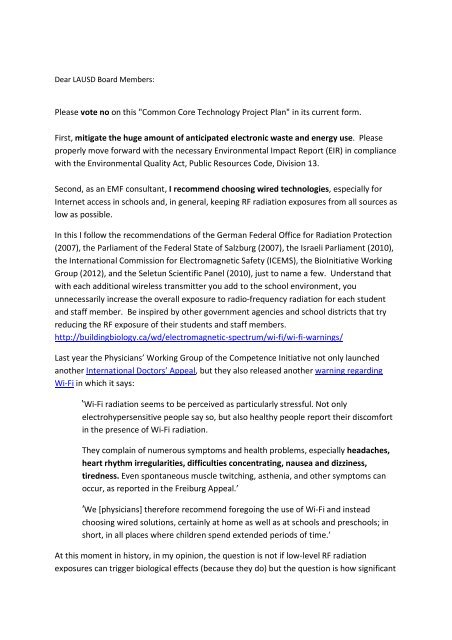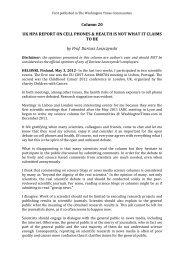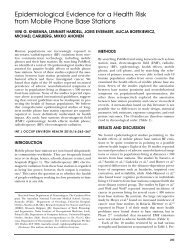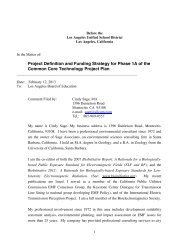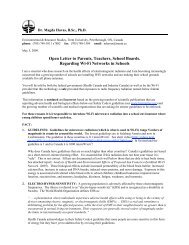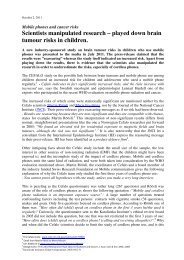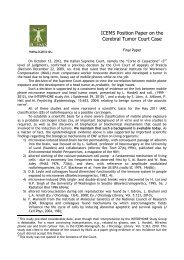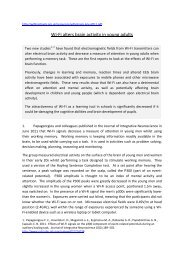Katharina Gustavs - WiFiinschools.org.uk
Katharina Gustavs - WiFiinschools.org.uk
Katharina Gustavs - WiFiinschools.org.uk
You also want an ePaper? Increase the reach of your titles
YUMPU automatically turns print PDFs into web optimized ePapers that Google loves.
Dear LAUSD Board Members:<br />
Please vote no on this "Common Core Technology Project Plan" in its current form.<br />
First, mitigate the huge amount of anticipated electronic waste and energy use. Please<br />
properly move forward with the necessary Environmental Impact Report (EIR) in compliance<br />
with the Environmental Quality Act, Public Resources Code, Division 13.<br />
Second, as an EMF consultant, I recommend choosing wired technologies, especially for<br />
Internet access in schools and, in general, keeping RF radiation exposures from all sources as<br />
low as possible.<br />
In this I follow the recommendations of the German Federal Office for Radiation Protection<br />
(2007), the Parliament of the Federal State of Salzburg (2007), the Israeli Parliament (2010),<br />
the International Commission for Electromagnetic Safety (ICEMS), the BioInitiative Working<br />
Group (2012), and the Seletun Scientific Panel (2010), just to name a few. Understand that<br />
with each additional wireless transmitter you add to the school environment, you<br />
unnecessarily increase the overall exposure to radio-frequency radiation for each student<br />
and staff member. Be inspired by other government agencies and school districts that try<br />
reducing the RF exposure of their students and staff members.<br />
http://buildingbiology.ca/wd/electromagnetic-spectrum/wi-fi/wi-fi-warnings/<br />
Last year the Physicians’ Working Group of the Competence Initiative not only launched<br />
another International Doctors’ Appeal, but they also released another warning regarding<br />
Wi-Fi in which it says:<br />
‘Wi-Fi radiation seems to be perceived as particularly stressful. Not only<br />
electrohypersensitive people say so, but also healthy people report their discomfort<br />
in the presence of Wi-Fi radiation.<br />
They complain of numerous symptoms and health problems, especially headaches,<br />
heart rhythm irregularities, difficulties concentrating, nausea and dizziness,<br />
tiredness. Even spontaneous muscle twitching, asthenia, and other symptoms can<br />
occur, as reported in the Freiburg Appeal.’<br />
’We [physicians] therefore recommend foregoing the use of Wi-Fi and instead<br />
choosing wired solutions, certainly at home as well as at schools and preschools; in<br />
short, in all places where children spend extended periods of time.’<br />
At this moment in history, in my opinion, the question is not if low-level RF radiation<br />
exposures can trigger biological effects (because they do) but the question is how significant
the long-term adverse health effects will be. For a list of recent studies see the above Wi-Fi<br />
Statement. I urge you to apply the precautionary principle and create zones without<br />
wireless transmitters (incl. Wi-Fi, cordless phones, cell phones), especially in elementary<br />
schools.<br />
Laboratory tests of laptops have shown that the exposure level for a user can easily be<br />
greater than 100,000 µW/m2 when the laptop is placed in the lap, which is definitely higher<br />
than even elevated urban RF levels. The recently released EMF Guidelines by the EMF<br />
Working Group of the Austrian Medical Association consider any level greater than 1000<br />
µW/m2 ‘very far above normal,’ and greater than 10 µW/m2 ‘far above normal.’<br />
Do not be fooled by the URS report.* In my testing experience, people tend to adversely<br />
react to Wi-Fi radiation, starting at 100 µW/m2 (0.01 µW/cm2). And this is not a wholebody,<br />
time-averaged value, which would be much lower, but a peak value. The human body<br />
does not care about the ‘accepted practice’ of the FCC.<br />
Also, basic logic seems to escape the authors of the URS report. On the one hand, they<br />
claim that ‘a cautionary level of 0.1 µW/cm2 is attainable within LAUSD classrooms.’ At<br />
what distance from any device? At the user distance? From one single Wi-Fi device? For any<br />
scenario when all devices in a given classroom are working? How can recommendation<br />
number 3 on page 1-2 be reconciled with number 6? Does this mean that the<br />
recommended cautionary level only applies to a single frequency band, i.e. Wi-Fi? What<br />
about cumulative exposure from all the different types of wireless frequencies?<br />
Ambient exposure levels in a classroom with a Wi-Fi access point may range from 100-4,000<br />
µW/m2 (up to 90,000 µW/m2), depending on a person’s distance to the access point.<br />
Compared to the 10 million µW/m2 of the FCC limit, 1000 µW/m2 (0.1 µW/cm2) may sound<br />
rather small. Considering that the natural background radiation (in which human life has<br />
evolved) is over a billion times lower (ca. 0.000001 µW/m2), this may give you pause. For<br />
your orientation, I have compiled a table with the various Wi-Fi exposure levels.<br />
http://buildingbiology.ca/wd/wp-content/uploads/2012/10/Wi-Fi-Exposure-Levels-2012.pdf<br />
The electromagnetic quality of our indoor environment is part of a healthy learning<br />
environment. Just because we cannot smell RF radiation does not mean it cannot cause any<br />
harm at low levels. Be smart; invest in wired networks and the future health of our children.<br />
Educate them about using wireless devices more safely. We have a choice. Low-emission<br />
electronic devices and installation methods should be used to create a healthy learning<br />
environment and to be inclusive of those who are electromagnetically hypersensitive. For<br />
inspiration, check out my paper on Low-EMF Office Environments.<br />
Respectfully,<br />
<strong>Katharina</strong> <strong>Gustavs</strong>, Cert. EOH<br />
Building Biology Environmental Consultant IBN
www.buildingbiology.ca<br />
p. 250.642.2774<br />
Rainbow Consulting<br />
5237 Mt. Matheson Rd.<br />
Sooke BC V9Z 1C4<br />
Canada<br />
*URS Report<br />
Page 1-1<br />
‘A review of international RF EMF protection standards reveals that the lowest value is 10<br />
µW/cm2 (Russia, Switzerland) and the highest value is 1,000 µW/cm2 (United States).’<br />
For the record, the lowest international RF protection standard is 2.4 µW/cm2<br />
(Ukraine http://zakon4.rada.gov.ua/laws/show/z0488-96/page ). Not 10 µW/cm2!<br />
2.4 µW/cm2 can be easily exceeded at close range of a Wi-Fi access point or Wi-Fienabled<br />
tablet.<br />
In addition, Switzerland issues an RF protection standard regarding cell tower<br />
radiation for sensitive areas, including schools and hospitals, that ranges from 4.2 to<br />
9.5 µW/cm2.<br />
(http://www.bafu.admin.ch/elektrosmog/01100/01101/index.html?lang=de ).<br />
For a list of current exposure limits and precautionary recommendations see my<br />
table, including links to source documents: http://buildingbiology.ca/wd/wpcontent/uploads/2012/09/2012-8-Cell-Tower-Guidelines.pdf<br />
p. 3-10<br />
The authors of the URS report make the following comment regarding the study by Foster<br />
from 2007 http://www.medfordumc.<strong>org</strong>/celltower/wifirfexposure.pdf<br />
’The RF signal from most of the networks surveyed was usable by the laptop, but the signal<br />
was too small to be measured by the highly-sensitive RF EMF meter employed in the study.’<br />
How does URS define ‘highly-sensitive RF EMF meter’? The NARDA RF meter used in<br />
this study was unable to detect any signal below 100 µW/m2 (0.01 µW/cm2), the<br />
threshold level at which many people start reacting to Wi-Fi exposures. This<br />
statement lures the reader into a false sense of safety. For public health, an RF<br />
meter should be able to detect levels down to at least 10 µW/m2, better yet 0.1<br />
µW/m2. The manufacturer of this particular RF meter usually suggests using the<br />
SRM 3006, instead of the SRM 3000, for exposure assessments regarding public<br />
health. Instead of average values peak values should be monitored.


